The power of spring in Horizon Zero Dawn, Everybody's Gone to the Rapture and The Last of Us
Life finds a way.
After the darkness and dormancy of winter life restarts, almost as if the punishing frosts, snows and winds had never happened. The season of spring starts to take hold, colours reappear, foliage regrows and landscapes transform to offer different looks, feels and opportunities for interaction. This can be truly impactful when it manifests in video games. Where winter revealed the bones of landscapes and their design, spring brings a softer touch, its re-birth and revitalisation draping life and colour back over lands. Spring can empower a landscape to represent and symbolise in its own way. By adding these into games' story arcs and narratives, a whole new side of the landscape can be seen and experienced - one where the land tells stories of recovery, shows an ability to cleanse and has an ability to enhance peace and quiet, all while under the drape of a colourful, full of life landscape, giving the land an entirely new look and atmosphere.
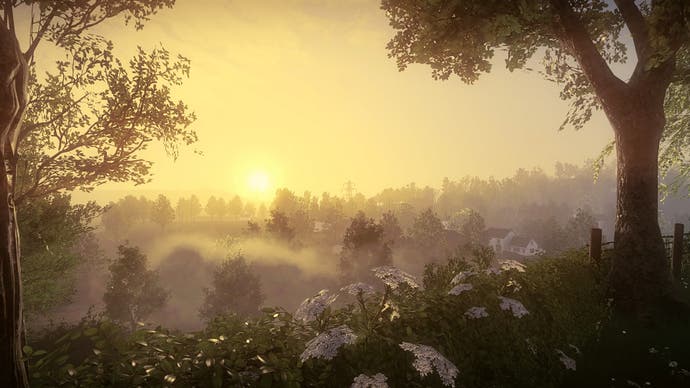
Within Horizon: Zero Dawn's expansive, detailed and believable landscapes are fine spring elements and characteristics. Used through both massive and minute brush strokes, plants show spring's power on the land and establish an environmental connection between Aloy and the narrative. As a result, Horizon is a great example of how spring can shape and transform an environment and its landscapes, elevating it to something beyond a plant-filled, softer, greener playground.
Small plants lead the way across Horizon's landscapes. The vibrancy and regrowth of grasses plants show the revitalisation of the land is in full swing. Swathes of meadow grass ripple across the landscape, but even grassy plants in forests and on hillsides dominate their locales. The blocks of red grasses, interacted with heavily throughout by Aloy, show the importance that one particular plant group - one that is always early to make a reappearance in spring - has in demonstrating spring's impact. The coverage of grasses is widespread and immediately shows spring's softening of the land - particularly in juxtaposition to the nearby, still-snowy areas.

Ornamental plants continue this trend and it is with these plants that big splashes of colour are thrown around the landscape through often big brush strokes - more of a modern concept in garden or landscape design (generally). Almost sticking to a designed-in palette, whites and yellows are particularly abundant. White, collared aquilegia-esque flowers wave among the low grasses, making for a lush bed of spring plants, their flowerheads like spinning plates above the swords of grass. Taller, yellow specimens - a true colour of spring - make bold ribbons of colour around rocks, paths and across meadows. Mix in some splashes of red, poppy-like flowers and blue plants reminiscent of lupines along the way and, if you were asked to plant a garden for spring time, this is the kind of effect you'd strive to include. Deploying them in great quantities and drifts like this is a bold method of design but also represents the impact of spring on the land and its ability to breathe colour and life back into the landscape, removing all sign of winter's bareness and dormancy.
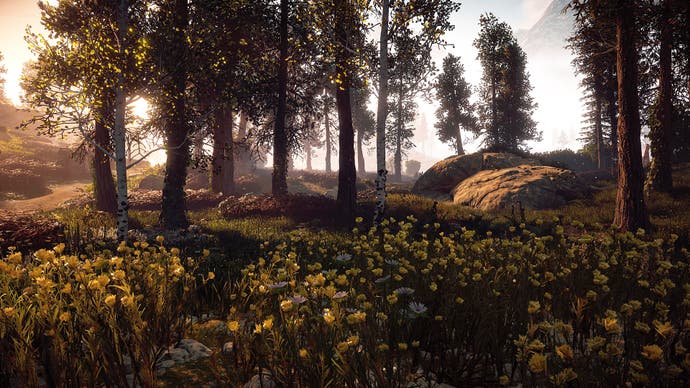
Away from the more open areas, Horizon's forests contain small but delightful ornamental plants, and are often deployed to demonstrate successful and appropriate planting combinations. This kind of horticultural detail improves any game's landscape, but using the particular spring specimens like lily of the valley-esque plants, broad-leaved bergenia-type foliage plants, clambering ivies and ferns together seems to imply some genuine use of spring and its plants. The result of this execution is a transformation of the land and its feel and atmosphere, as plants reclaim space on the landscape, softening it and recovering the environment from the harshness of winter.

In the same forests, the trees on display make for quality landscape features and spring elements, from the species chosen to their composition. Birch trees are prevalent in Horizon's landscape and are an important species to a spring landscape, due in part to their characteristic of being a pioneer species - a species that is one of the first to establish, particularly after trauma. Birch trees' distinctiveness is often reinforced by repetition as all the trees started life at the same time, are of the same age, and their cycles are in sync - a detail that can be seen in Horizon, where birches are of the same height and are often seen in groups. This establishment and prominence as a spring tree could be representative of Aloy's establishment in her world. Their seeds' lightness and capacity to travel far, and their tolerance of unpromising soils and hostile conditions, often in unrewarding locations - rather tellingly, in Horizon's case, post-industrial landscapes are famous for quickly being covered in birch saplings - further enhances their prominence as a symbolic spring tree. Due to their beauty and ability to regenerate itself early on in spring, they also have a sacred quality attached to them, and are seen to have powers of renewal and purification - representative of a purification the land is going through after the catastrophe 1000 years before, perhaps. It is quite possible to enjoy forests of just birch trees in our real world in spring time - a look and feel enhanced by their distinctive and pleasant white bark - but in the absence of large-scale changes they can be scattered among others to create dynamic open spring woodlands. In Horizon we see them combined with other deciduous trees, also in early, lush leaf and some pines that look more vibrant and vivid in the spring sunshine. Birches are truly a tree of spring and this horticultural quality, complemented by their representative and symbolic meanings, mean they are perfect for Horizon's landscapes.
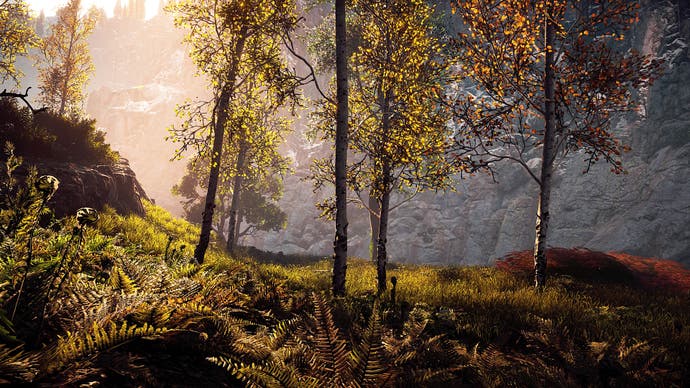
Where the trees are, be they dense forests or open glades, are completed with rough, woodland-y underplantings, and climbing ivies clambering up their trunks. Combine these with the sunshine and spring haze and a very particular spring atmosphere is created and can be felt. The spring sunshine bathing these areas in light - a different light to that of winter - makes even the air feel brighter and different, intimating a more positive atmosphere and feel to the environment. It may be subtle but light and plants combining like this is very evocative of springtime and the change that it is governing upon the landscapes.

Spring and its rebirth could be argued to mirror, pretty neatly, a great many thing in Horizon: from Aloy's rebirth, returning from being an outcast, to the larger scale theme of a struggling humanity and their regression to hunter gatherers (symbolising the species' 'winter'), regrowing and redeveloping in an effort to succeed and change (a new 'spring' for them). However, it is Horizon's spring plants and their transformative effect over the land that underpins the power and impact of the environment and accentuates and finishes the narrative-mirroring qualities it contains.
The same, seemingly deliberate, use of forests and spring light can also be seen in Everybody's Gone to the Rapture. It's quintessentially English spring forests feature the same birch trees - appropriate due to the location and aesthetic but also important due to their cultural meaning and representations of renewal and life - but complemented with massive carpets of bluebell type plants. This remains true to the English countryside and also demonstrates a genuine planting combination for that time of year - it immediately evokes spring. Woodlands like these are postcard images for a UK spring, but their untrodden paths in Yaughton give a nod to the apparent unease and mystery in the village, making for an eerie spring, peaceful and weirdly quiet, yet vivacious in its landscape.
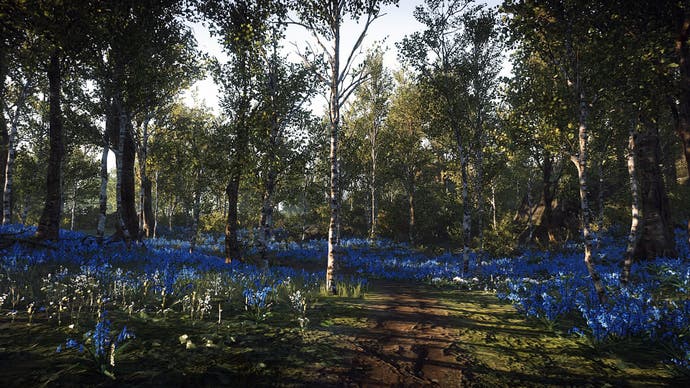
This theme of eeriness and stillness perpetuates over all of Yaughton and, while sometimes blurring the spring and summer boundary, the whole village seems like a complete, springtime-designed garden. Extending from the spring forests complete with accurate plantings and dappled light-infused atmosphere, the rest of the landscape includes typical features of a late-spring garden, creating a distinct and pleasant yet powerful place: flowering pears provide more ornamental trees, their white blooms punctuating the lush green; hedges with spring-induced lushness hug boundary walls; groundcover plants like vincas smother and reclaim rocks and winter-worn paths, reintegrating them back into the landscape under spring's wing; and a stream gently meanders and bubbles its way through the landscape. Examined separately, these would neatly describe features found in a very English, very spring-y garden. Finished with the almost heavenly, ethereal spring sunlight and these combine beautifully in Yaughton.
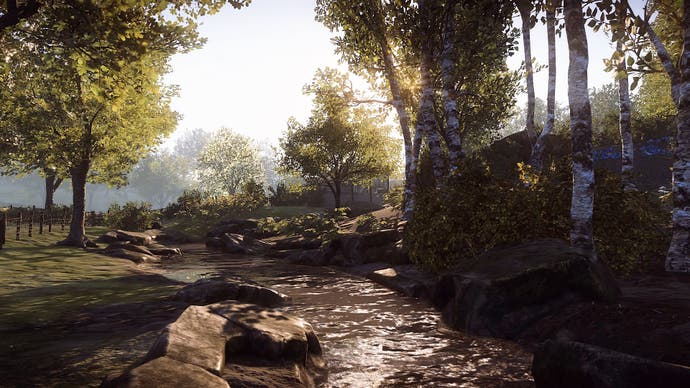
However, despite this abundance of life and power, and almost counterintuitively, Everybody's Gone to the Rapture's use of spring seems to be used in contrast to life or rebirth. The landscape is full of life, yet the people are all absent or dead - a powerful contrast between absolute life and the absolute absence of life the game highlights in its narrative. However, this does seem to enhance the landscape's impact, creating an eerie-yet-pleasant place, its quiet beauty turning an entire village in to a spring garden, but still managing to exaggerate the sense of mystery and the feeling of non-life present in the village.
The use of the seasons in The Last of Us is famous for being the division of game and its story but they go beyond being convenient breaks and beyond being a method of varying the settings' backdrops. In particular, spring brings with it the lushness and new life in its plants that is familiar, but its ability to represent regrowth, cleansing and new life fits neatly into the game's wider themes, setting and character development.
When spring first appears, we are immediately presented with lush greenery, foliage and plants growing back and making a pleasing return. After the dead landscapes of the winter chapter, this is a positive relief and a pleasant change from the unforgiving, hardened landscape and its trials that came before. With plants such as wall-smothering climbers unleashed, and uncontrolled deciduous trees coming back with a vengeance, displaying their new-found vitality by smothering cars, roads and buildings once again, the environment offers a subtle, mirroring reminder to the renewed impetus Joel and Ellie have in reaching their goal. No doubt fuelled by their recovery from winter and its dark events of Ellie's confrontation with David and Joel's near-fatal condition, and the life presented by the plants enhances this.
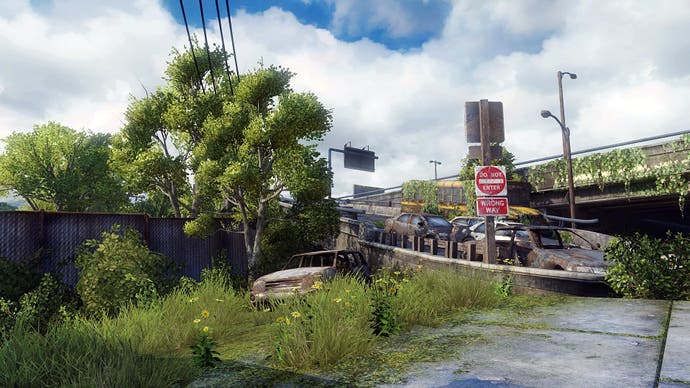
Along with Ellie's post-David recovery, the spring landscape mirroring Joel's attitude and recovery is particularly good here. The positivity of the plants' regrowth reflects Joel's recovery back to full health, who highlights this himself as he happily comments on the weather, talks about teaching Ellie the guitar and generally feels like a man nearing his goal. As spring wipes the landscape of death and starkness, Joel's mind is clearer, too, having a newly-rejuvenated spirit, finally accepting of his past and the loss he suffered. His manner seems far more optimistic, mirroring the cleansing, resetting capacity spring has. Simultaneously, it seems Joel shares this with the earth in general: the greenery and plants smothering the manmade structures and landscape representing nature's own rebirth.
At the end, Joel and Ellie set off on foot, for the last part of their journey, through a beautiful, mountainous spring landscape that epitomises life. This spring landscape, complete with lupin-esque plants, small, rampant groundcovers, ferns and yellow doronicum-like flowers waving in the breeze, is a long exhale after the journey's climax in the grim hospital. It's almost strange not to see birch trees used here, their representative qualities would have been most apt.

It's quite telling this is one of the very few, if not the only, places where Joel and Ellie briefly discuss the landscape. Rewarding the characters after their intense and draining journey with possibly one of the lushest landscapes in the game seems fitting after all they have endured. It is only at this point, in spring, that they can enjoy their surroundings for a moment: a gorgeous view of a spring landscape, complete with a free-running natural stream, tellingly flowing directly toward the settlement - all a reflection of their new life to come, perhaps.

It seems rather symbolic that spring is deployed as the last and final chapter and season in The Last of Us, the rebirth, revitalisation and regrowth all present and clear in all elements of the narrative and the characters. However, that little, knowing 'okay' from Ellie before the game finishes offsets the positivity ever so slightly, the one word contrasting the environment and its meaning.
When it comes to the warmer, lighter and more colourful seasons, some games blur the boundary between spring and summer. But, there are always elements of each that remain distinct - all it takes is a little detail and attention - and the results can be gorgeously vibrant virtual environments. Aesthetically we see an enormous range of plants on display, seizing their chance at another cycle of life and regenerating a whole landscape, combining to create a spring garden that symbolically contrasts a game's events, and the capacity of spring to enhance and mirror the events of a story or characters' trials.
Following on from the deep dormancy of winter, these details, techniques and spring features invigorate landscapes. They imbue them with a sense of life, regeneration, and renewed positivity that the season of spring is known for, and, as our real-world spring arrives, we can enjoy the effect of the season on the land doubly, our virtual spring reinforcing our fondness of the real one.

